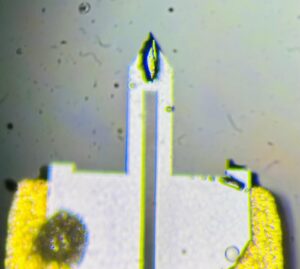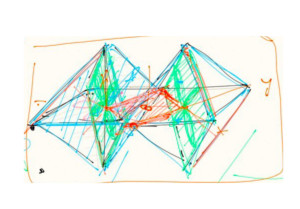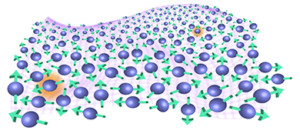Current Projects
New materials continually demand advances in measurement capabilities; not only because sample constraints limit the applicability of some techniques, but also because of the ever-increasing complexities of new materials. We always start with the question, “What do we want to understand about this material?” and then ask, “Which information will be most disclosing, and how can we access it?” This page provides some examples of this methodology in the context of some current projects.
Project 1: Symmetry breaking in superconductors

Unconventional superconductors could play a crucial role in developing topological quantum computing. A potential component for this development is spin-triplet superconductors, which are characterized by electron pairs with an odd wave function in a spin-1 state. Helium-3 is the only known realization of this state, calling for a search for bulk materials that can host spin-triplet superconductivity. UTe2, a heavy-fermion that superconducts between 1.6 K and 2.1 K depending on sample quality, has emerged as a promising candidate. This material has a rich anisotropic phase diagram, exhibiting high-field metamagnetism and superconductivity. Sensitive measurements of magnetic anisotropy are the group’s main expertise, and there are several possible sources — localised spins in magnetic insulators, Landau diamagnetism in metals, or anisotropic vortices in superconductors. This gives us a window into a multitude of condensed matter states. We also have experience using DC and pulsed magnetic fields, which may be critical to understand the relationship between superconductivity and magnetism in many unconventional superconductors, including UTe2 for example.
Project 2: Anisotropic exchange interactions in quantum spin systems
 Interest to find highly anisotropic spin interactions on a honeycomb lattice has been brewing since Kitaev’s model for a quantum spin liquid appeared in 2006. Three years later, real materials resembling this model were put forth and ever since, huge efforts have been taken to try to understand these systems. On the prime candidate RuCl3 alone, 5,000 papers in just 5 years have led to a number of exciting observations, but the exchange tensor — the most basic descriptor of how spins interact with each other — is still under debate. Using a technique recently developed in our lab, we will explore the magnetic anisotropy of spin liquids both as a function of temperature and magnetic field. With advanced methods to determine and align the crystal axes in small (10s of nanograms) single crystals, we will rotate the high-symmetry directions with respect to the external magnetic field with milli-degree precision — a substantial improvement over existing setups. Detailed mappings of the magnetic anisotropy with respect to magnetic field orientation in the crystal will allow us to determine the exchange tensor in candidate materials and help guide the search for spin liquids.
Interest to find highly anisotropic spin interactions on a honeycomb lattice has been brewing since Kitaev’s model for a quantum spin liquid appeared in 2006. Three years later, real materials resembling this model were put forth and ever since, huge efforts have been taken to try to understand these systems. On the prime candidate RuCl3 alone, 5,000 papers in just 5 years have led to a number of exciting observations, but the exchange tensor — the most basic descriptor of how spins interact with each other — is still under debate. Using a technique recently developed in our lab, we will explore the magnetic anisotropy of spin liquids both as a function of temperature and magnetic field. With advanced methods to determine and align the crystal axes in small (10s of nanograms) single crystals, we will rotate the high-symmetry directions with respect to the external magnetic field with milli-degree precision — a substantial improvement over existing setups. Detailed mappings of the magnetic anisotropy with respect to magnetic field orientation in the crystal will allow us to determine the exchange tensor in candidate materials and help guide the search for spin liquids.
Project 3: The dynamics of spin liquid excitations

Spin liquids are often characterized by their lack of magnetic order, but what actually makes them interesting is their low-energy excitations, such as Majorana fermions or spinons. Discovering these excitations in a bulk material will provide a more robust route toward quantum computing. The challenge is that the excitations of spin liquids are electrically neutral, prohibiting the use of standard experimental and theoretical methods that have been developed to study charged excitations. We are developing new ways to probe the excitations of spin liquids. In particular, frequency-dependent measurements will allow us to characterize the dissipative response of the excitations. We will start with Tb2Ti2O7 and TaS2, materials exhibiting hints of the slow dynamics expected of a spin liquid. By controlling the sample size and measuring in the 2D limit, and by accessing the long-wavelength part of the susceptibility, this work will allow us to form a more complete picture of quantum spin systems.
Contact Us
Interested in learning more about our ongoing projects or past work? Get in touch using the form below.
